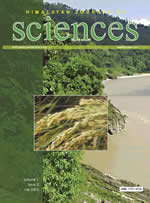Invasive alien plants and <i>Eupatorium</i>: Biodiversity and livelihood
DOI:
https://doi.org/10.3126/hjs.v1i2.213Keywords:
Invasive alien plant species, Eupatorium, biological control, livelihoodAbstract
Invasive alien species colonize aggressively, threatening native biodiversity. The success of invasive alien plants is due to their opportunistic exploitation of anthropogenic disturbances, the absence of natural enemies, and, frequently, their allelopathic competitive strategies. Invasive species can have a significant impact on development, affecting sustainability of livelihood, food security and essential ecosystem services and dynamics. Eupatorium adenophorum Spreng. and E. odoratum L. (forest killer, local name banmara) are unpalatable and highly competitive. They have taken hold in scattered sites throughout eastern and central Nepal, currently, they are also rapidly spreading westward. Efforts are being made to control established invasive species, but a better understanding of why species become invasive offers the possibility of taking pre-emptive measures. Key words: Invasive alien plant species, Eupatorium, biological control, livelihood Himalayan Journal of Sciences 1(2): 129-133, 2003Downloads
Download data is not yet available.
Abstract
1691
PDF
1863
Downloads
How to Cite
Kunwar, R. M. (2006). Invasive alien plants and <i>Eupatorium</i>: Biodiversity and livelihood. Himalayan Journal of Sciences, 1(2), 129–133. https://doi.org/10.3126/hjs.v1i2.213
Issue
Section
Articles




